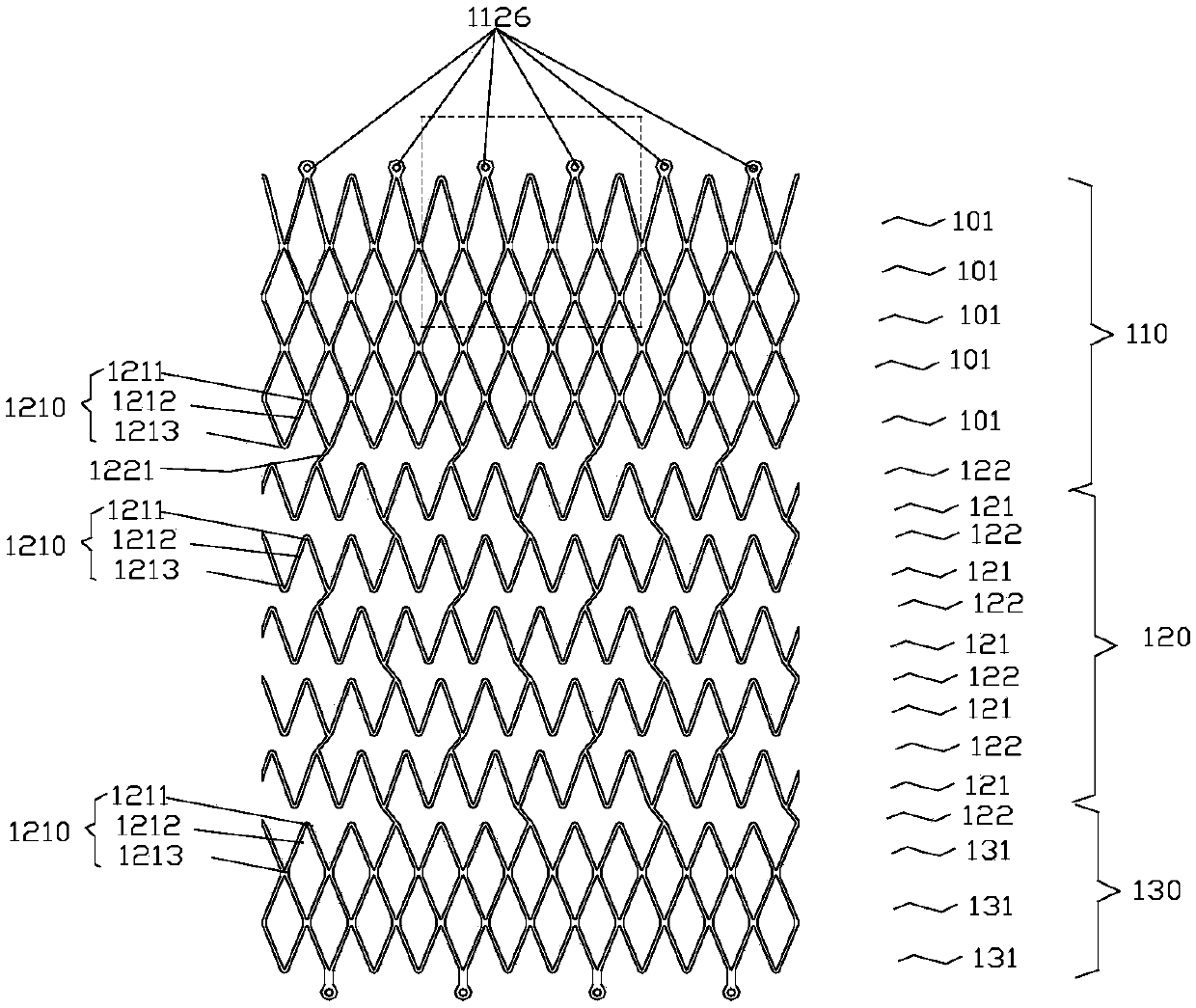Bifurcation-adjacent part lesion applicable stent
A site and bifurcation technology, applied in stents and other directions, can solve the problems of not being able to completely cover the lesion and the blood vessels not being attached, and achieve the effect of good support, good flexibility and bending performance, and uniform distribution.
- Summary
- Abstract
- Description
- Claims
- Application Information
AI Technical Summary
Problems solved by technology
Method used
Image
Examples
Embodiment 1
[0041]Embodiment 1, as Figure 3-4b As shown, a stent for lesions near the bifurcation is a tubular stent formed by a plurality of wave-shaped supports 101, 121, 131 axially connected together. The tubular stent includes a proximal support mechanism 110, The central supporting mechanism 120 and the distal supporting mechanism 130 are composed of three parts; the proximal supporting mechanism 110 , the central supporting mechanism 120 and the distal supporting mechanism 130 are ring structures respectively. In the above structure, the proximal supporting mechanism 110 , the central supporting mechanism 120 and the distal supporting mechanism 130 are all annular structures, so that the stent forms a tubular structural body. The ring shape in the present invention means that the corrugated support members 101 , 121 , 131 are connected end to end to form a ring.
[0042] The proximal supporting mechanism 110 , the central supporting mechanism 120 and the distal supporting mechani...
Embodiment 2
[0059] Example 2, such as Figure 5-6 As shown in , 13, this embodiment is based on embodiment 1 with some improvements.
[0060] A stent for lesions near the bifurcation, which is a tubular stent formed by a plurality of wave-shaped supports 1111, 1121, 121, 131 axially connected together, the tubular stent includes a proximal support mechanism 110, a middle The zone support mechanism 120 and the distal support mechanism 130 are composed of three parts. The settings of the central zone support mechanism 120 and the distal support mechanism 130 are similar to those in Embodiment 1, and will not be repeated here.
[0061] Different from Example 1, as Figure 5As shown, the proximal support mechanism 110 in this embodiment includes two parts, one part is the circumferential support part 111 connected with the central zone support mechanism 120, and the other part is the directional support part 112 arranged at the proximal end. Both are formed by corrugated supports. The prox...
Embodiment 3
[0066] Example 3, such as Figure 7-8 As shown, this embodiment is based on Embodiment 2 with some improvements.
[0067] A stent for lesions near the bifurcation, which is a tubular stent formed by a plurality of wave-shaped supports 1111, 1121, 121, 131 axially connected together, the tubular stent includes a proximal support mechanism 110, a middle The area supporting mechanism 120 and the distal supporting mechanism 130 are composed of three parts. These three parts are basically the same as in Embodiment 2, except that in this embodiment, the wave rods 1212 of the proximal supporting mechanism 110 and the distal supporting mechanism 130 are all selected as straight rods. , the wave rod 1212 of the support mechanism 120 in the central area is a special-shaped rod, specifically a Z-shaped rod.
[0068] In this embodiment, a connecting component 122 is provided with at least two connecting rods 1221, and the connecting rods 1221 are fixed between the crest unit 1211 or the ...
PUM
 Login to View More
Login to View More Abstract
Description
Claims
Application Information
 Login to View More
Login to View More - R&D
- Intellectual Property
- Life Sciences
- Materials
- Tech Scout
- Unparalleled Data Quality
- Higher Quality Content
- 60% Fewer Hallucinations
Browse by: Latest US Patents, China's latest patents, Technical Efficacy Thesaurus, Application Domain, Technology Topic, Popular Technical Reports.
© 2025 PatSnap. All rights reserved.Legal|Privacy policy|Modern Slavery Act Transparency Statement|Sitemap|About US| Contact US: help@patsnap.com



